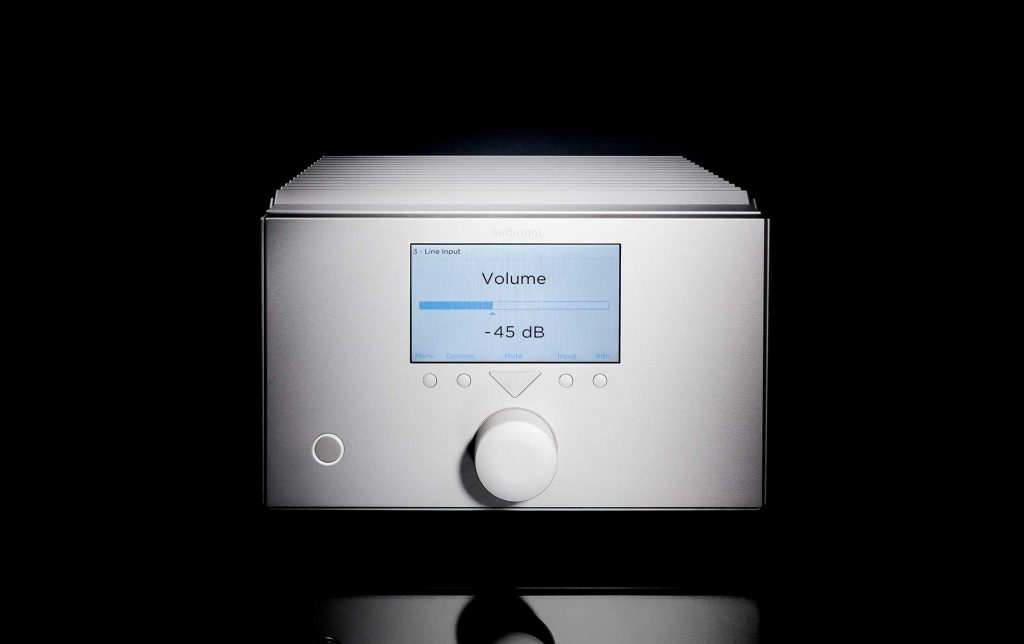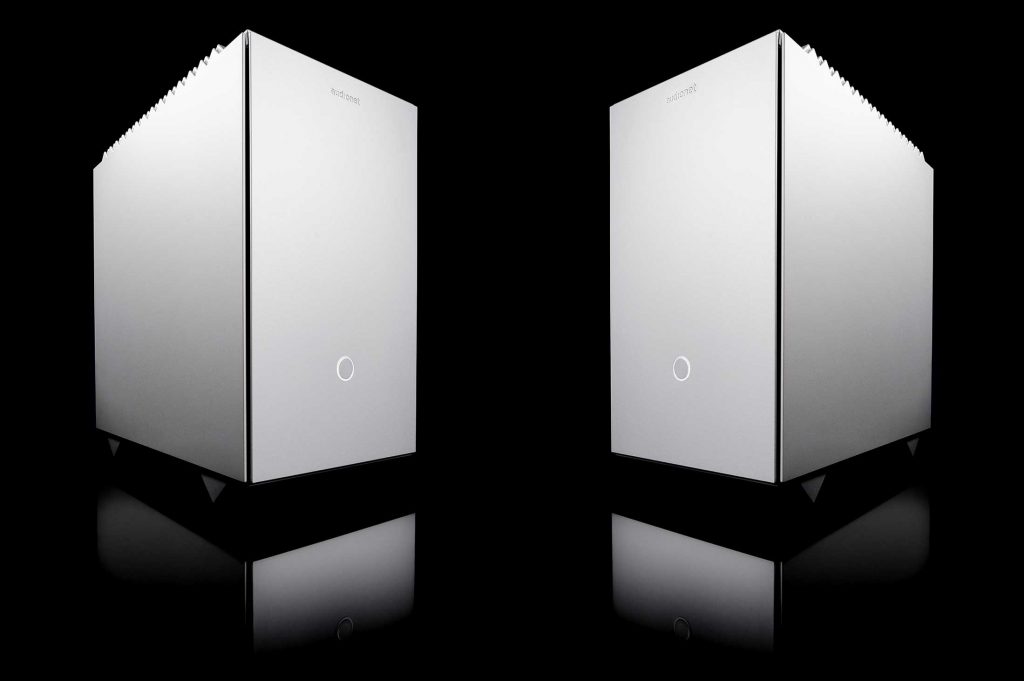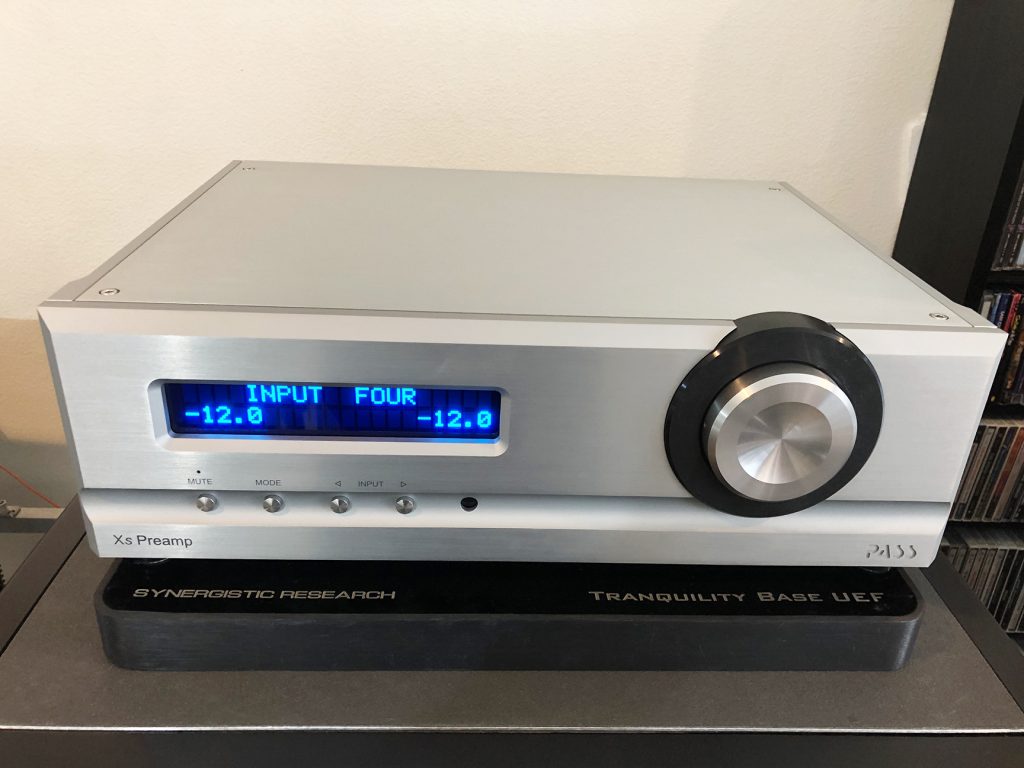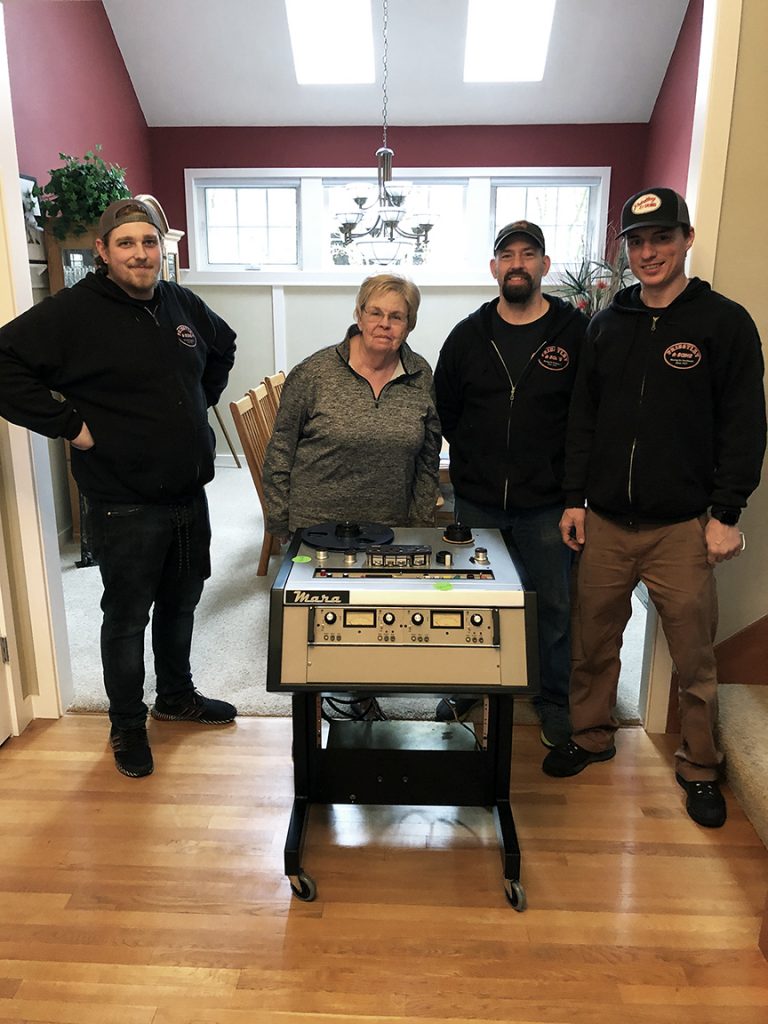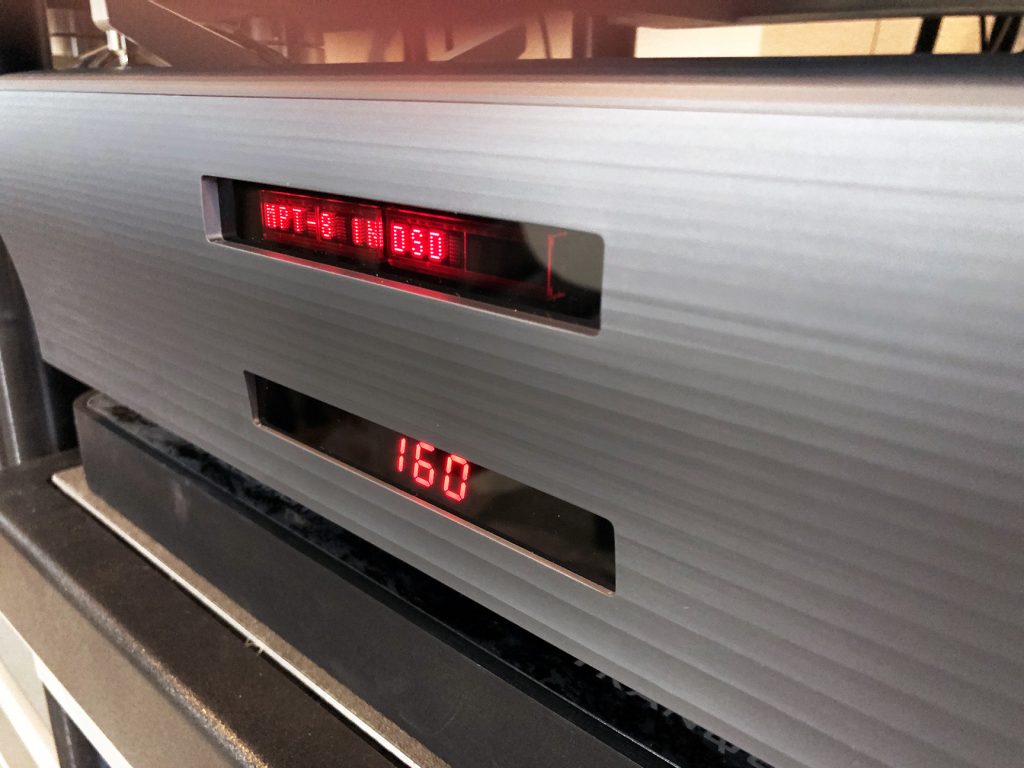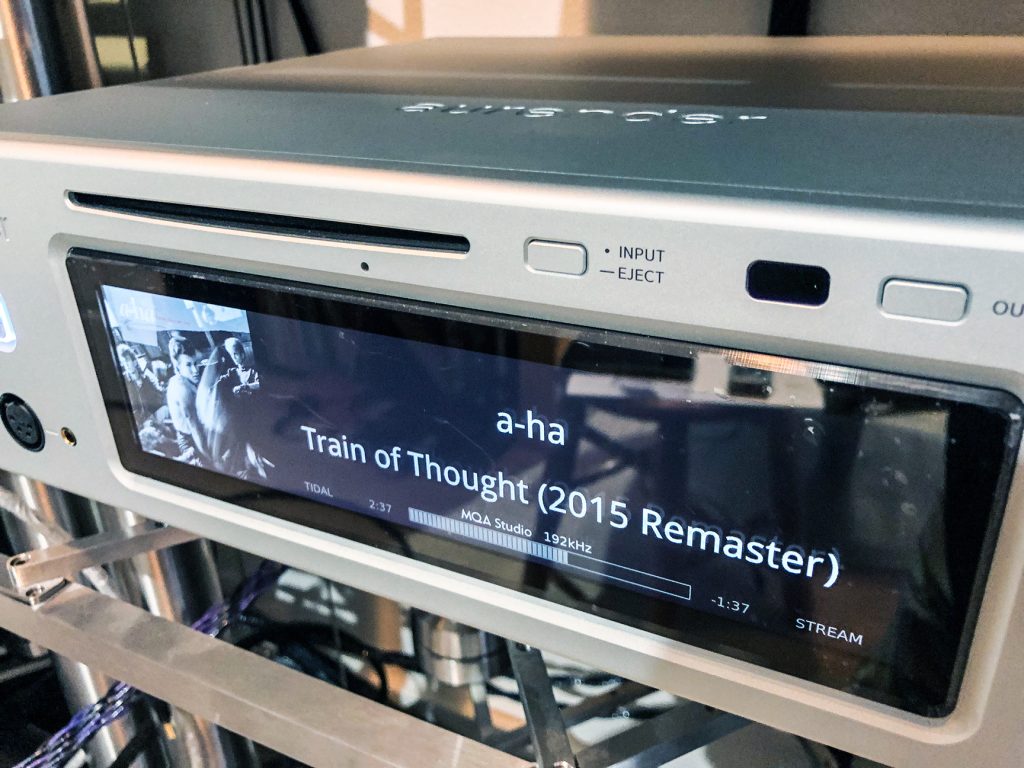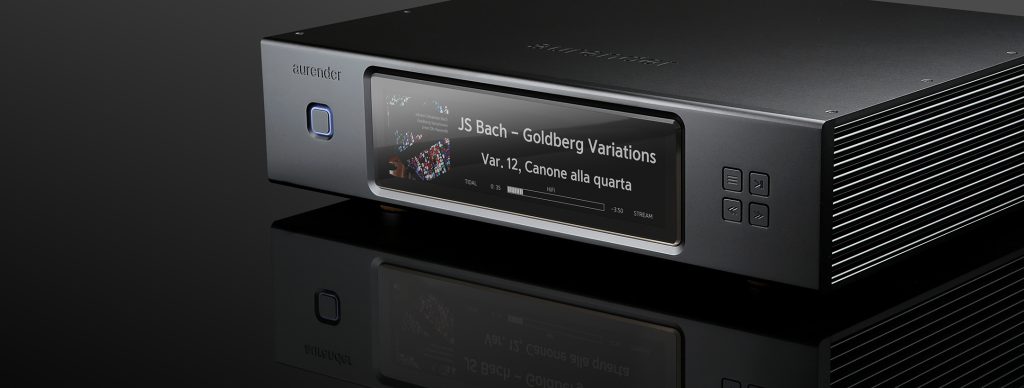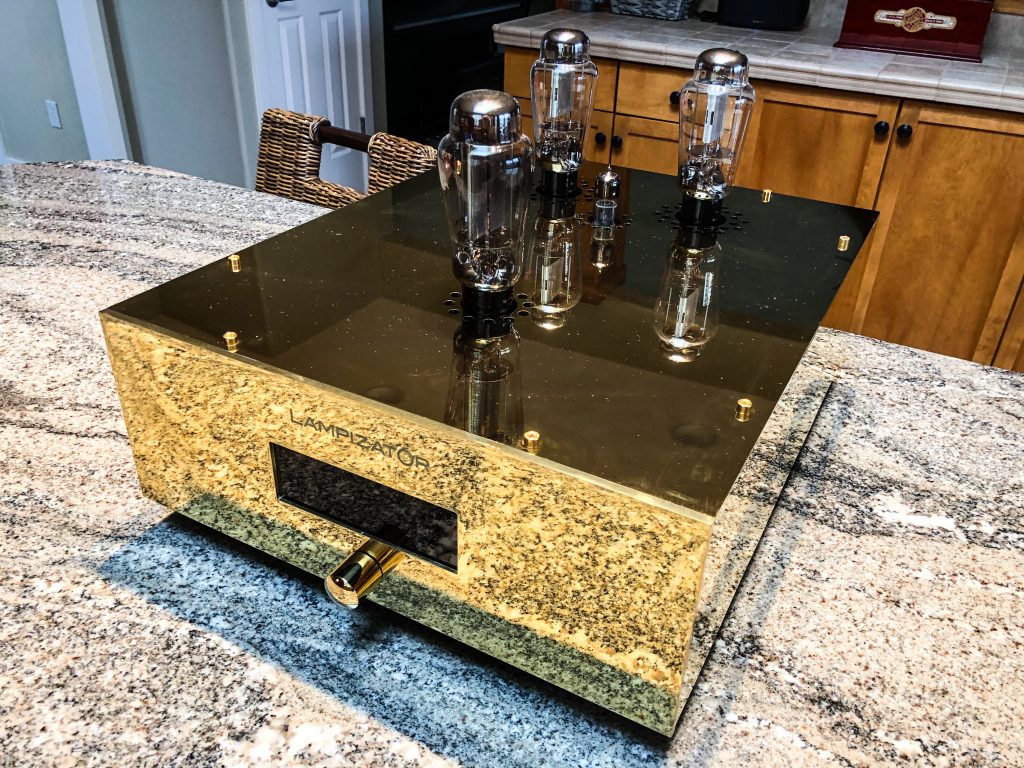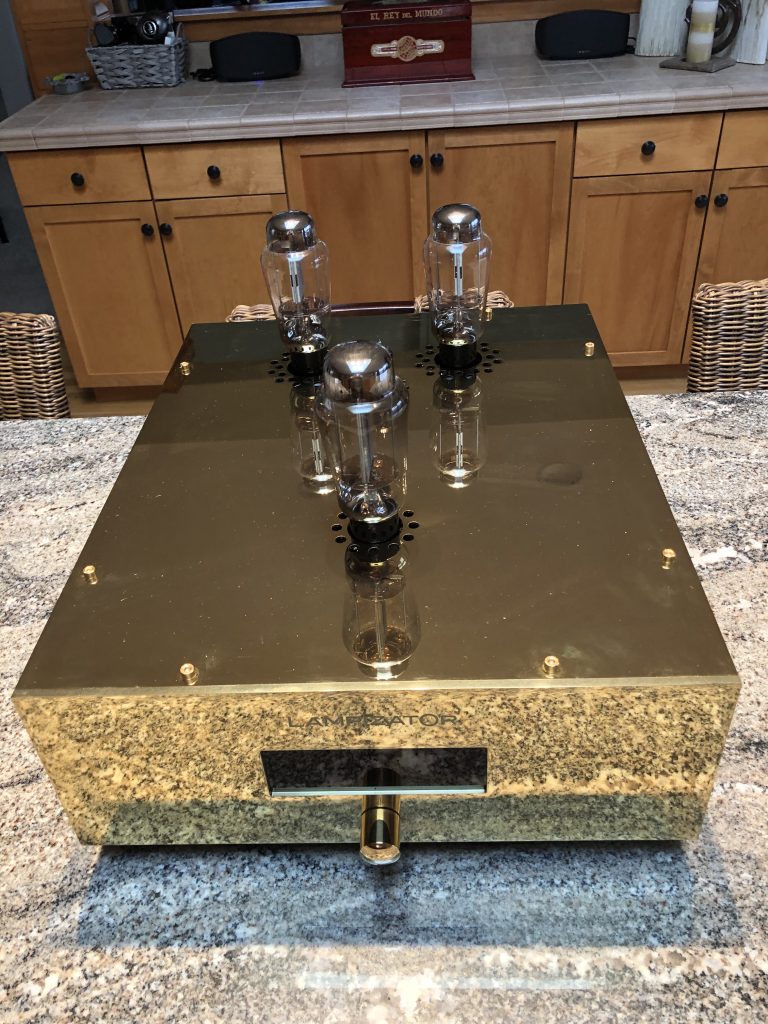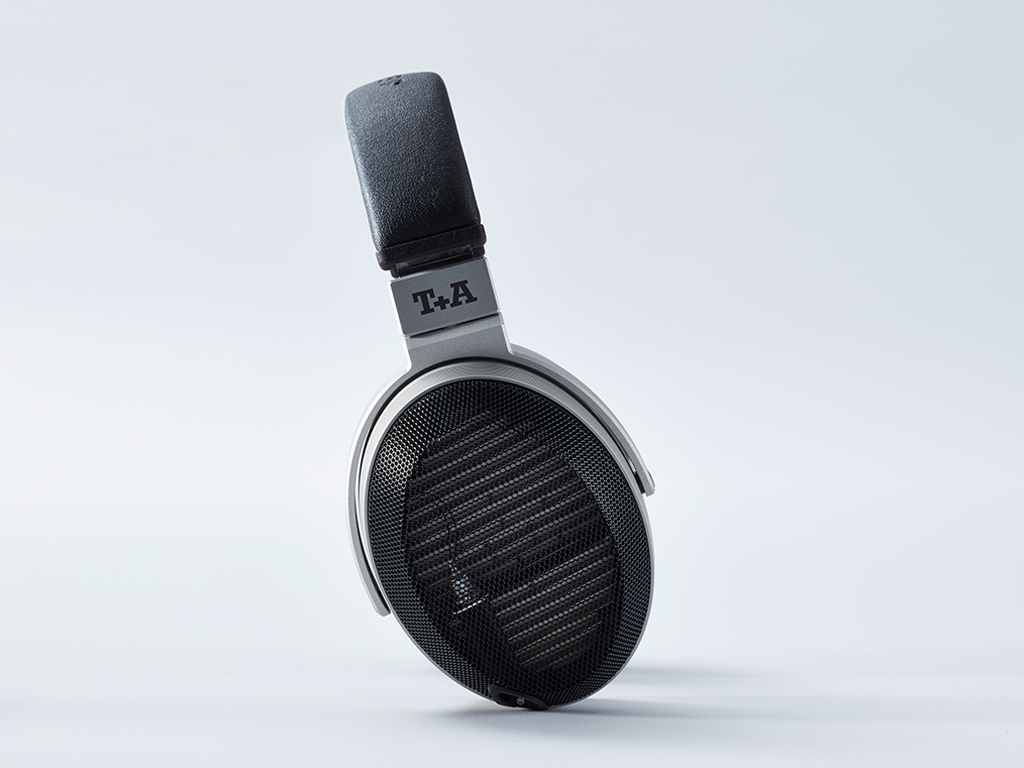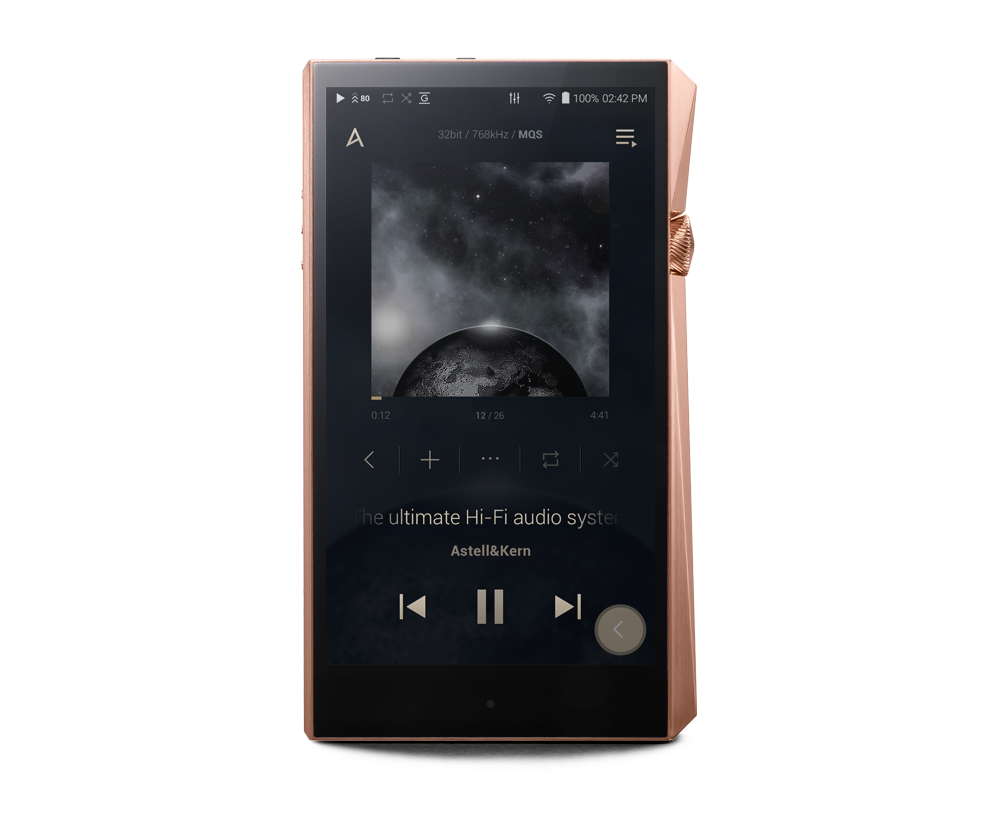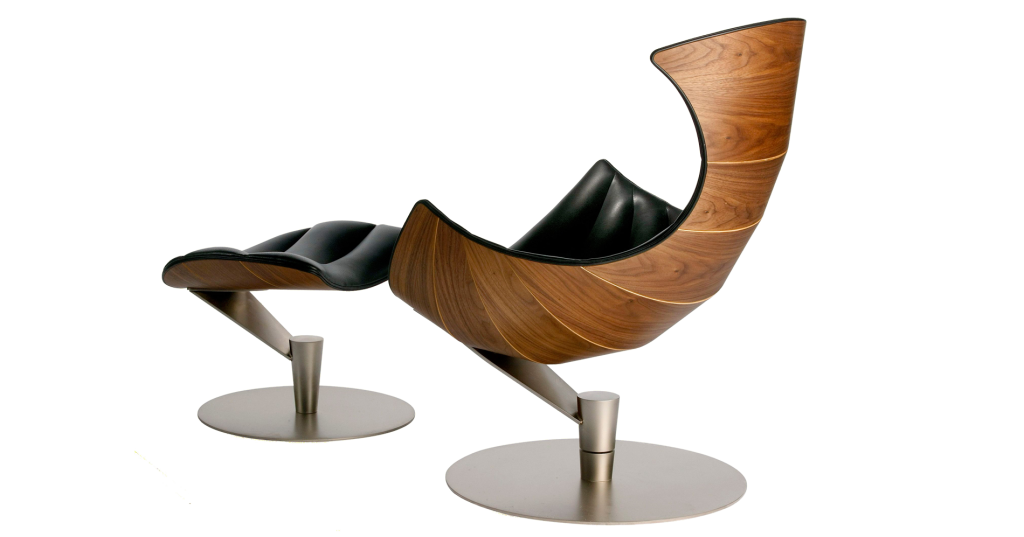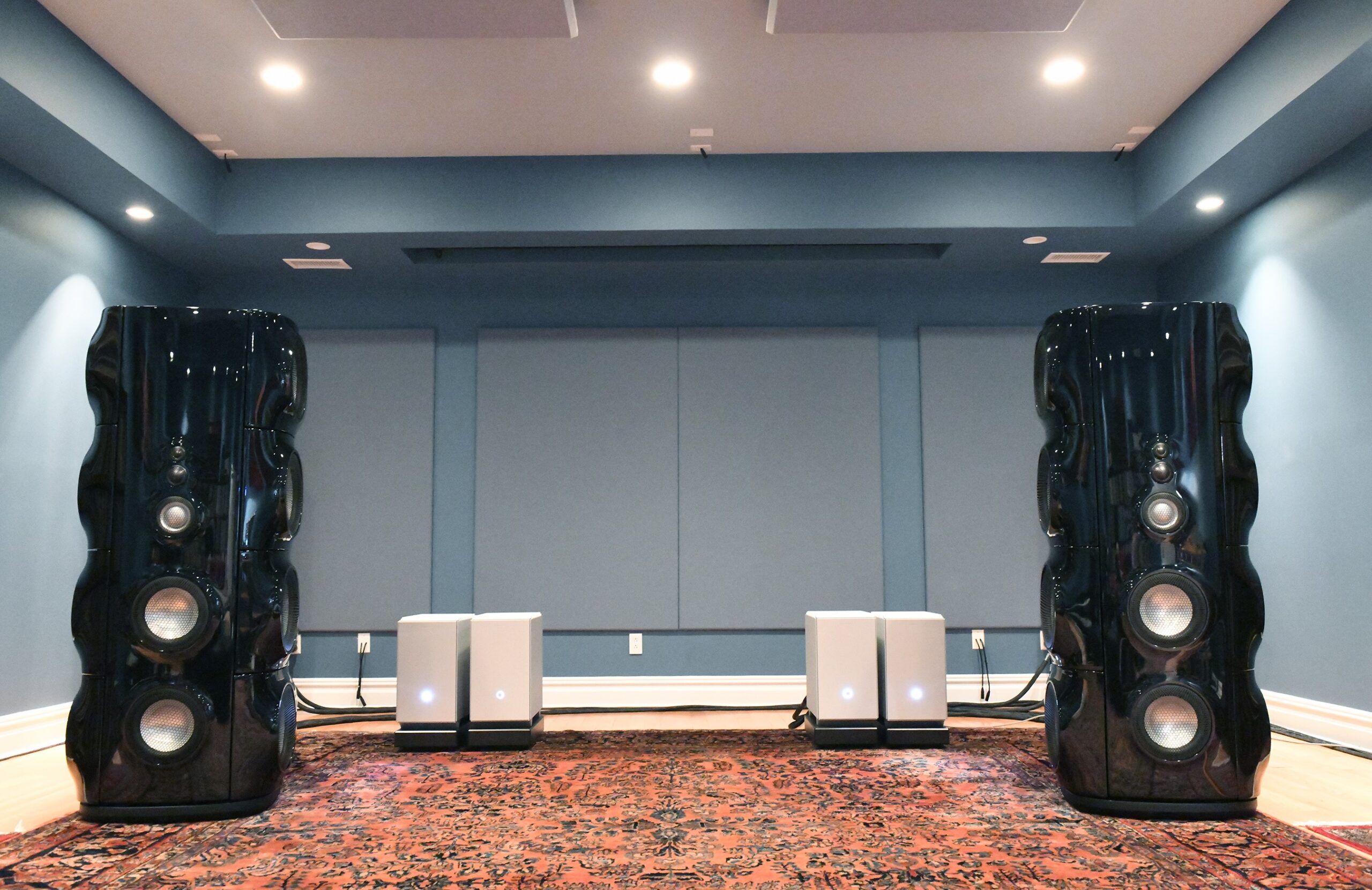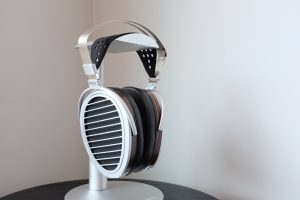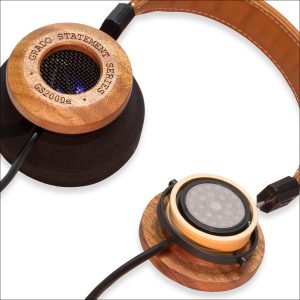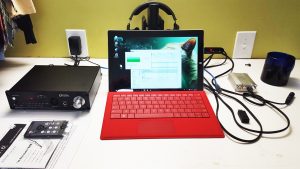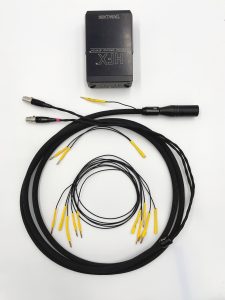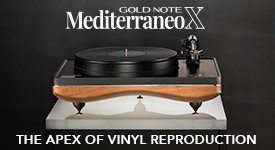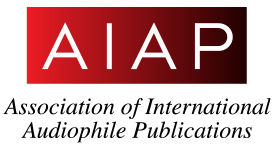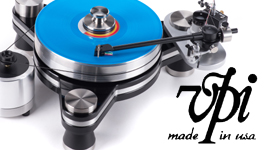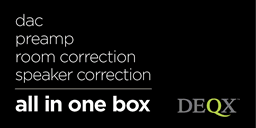...with comments on the Synergistic Research MiG SX Isolation Feet.

This is a story long in the coming.
Long, long, long.

Ye Olde Editor in contemplative mode, Happy Valley, OR, 2017… (Photograph by John Robinson; image processing by David W. Robinson)
By way of backstory…
You see, I've been following Warwick Acoustics and its predecessor company, Sonoma Acoustics, for a few years now. They have a solid team who have been behind their mission of producing a world-class reference for both high-end audiophile and professional use. I had first encountered the Sonoma team back in 2016. I had been sent a prototype of their Model One, which was not yet in production. Frankly, it was promising, but needed some work, and I shared my evaluation of what should be done.
In early 2017 I received the final production version of the Model One, which I evaluated at some length, and then issued my impressions photo essay on it way back in Issue 92, July/August of 2017. Overall, it was an outstanding performer at its price point of $5000 for both the headphones and the dedicated DAC/Amp. The only flies in the ointment for me were the fact that the Sonoma Model One topped out at Double DSD (DSD128), and…more significantly…that it converted all inputs to 384kHz/24-bit PCM.
In other words, no Native DSD mode at all. Not good.
Thus, I had to be somewhat guarded in my enthusiasm, which otherwise was very real. I was especially impressed by the High Precision Electrostatic Laminate (HPEL) headphones, which really seemed to one-up standard electrostats. Airy, spacious, detailed, and very quick without losing the lower end. Really promising! Especially since I am such an enthusiast for great electrostatic headphone systems.
Fast forward.
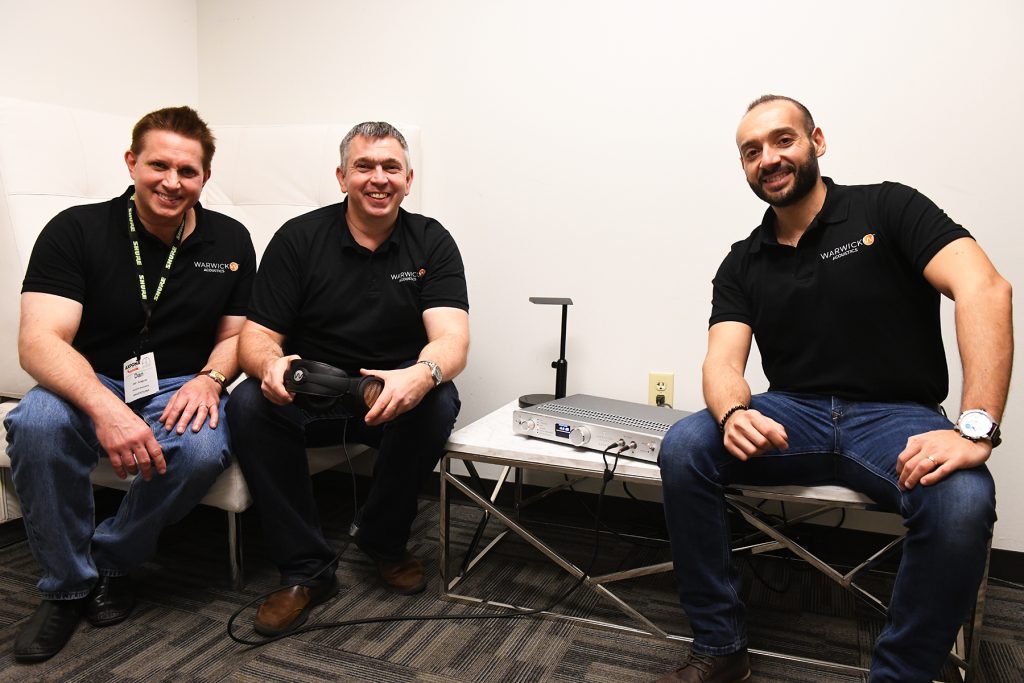
The Warwick Acoustics team with the new Aperio at AXPONA 2019. Left to right, Dan Anagnos, Martin Roberts, and Orazio Pollaci (photograph and image processing by David W. Robinson)
After a couple of years of development, and a company reorganization (the DBA shifted from "Sonoma Acoustics" to "Warwick Acoustics")…very tough things to do at the same time…the new company announced the release of the big brother to the Model One: The Aperio. The meaning of this name shows what Warwick Acoustics was looking for. In Latin, aperio means "to open, lay bare, reveal, make clear."
A great name. But would the Aperio really deliver on the promise of it?
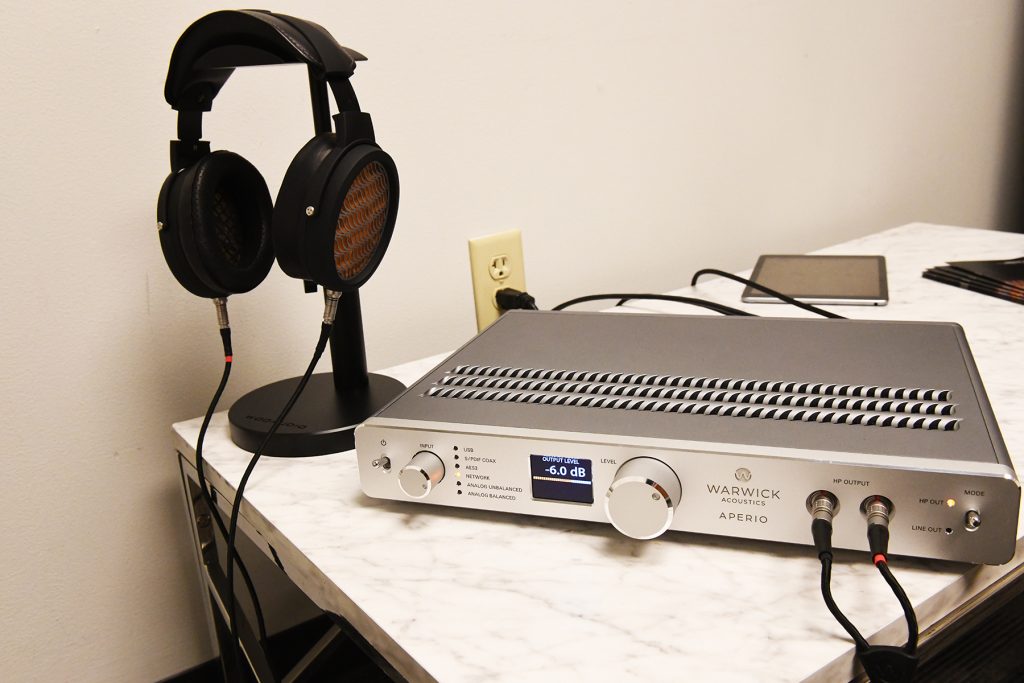
The Aperio at AXPONA 2019: beautiful, trim, and highly seductive (photograph and image processing by David W. Robinson)
Compared with the Model One, it was very evident that Warwick Acoustics had really gone all in with the Aperio. I only got to listen for a few minutes at AXPONA 2019, and that to some audio files that they were streaming via the Network Ethernet port, but what I heard told me that the Model One had already been aced. We talked about it, and they agreed to ship me a final production version ASAP.
…and more backstory…
As it turned out, that would be in just a few months. In late August of 2019, the Aperio finally appeared here, one of the very first shipped for evaluation. It arrived in a very high-quality professional-grade Pelikan-style shipping case. Wheels, retractable handle, multiple clamps, and fully lined with custom foam. Damn! This is the way to really do packaging right! Pro-grade, all the way.
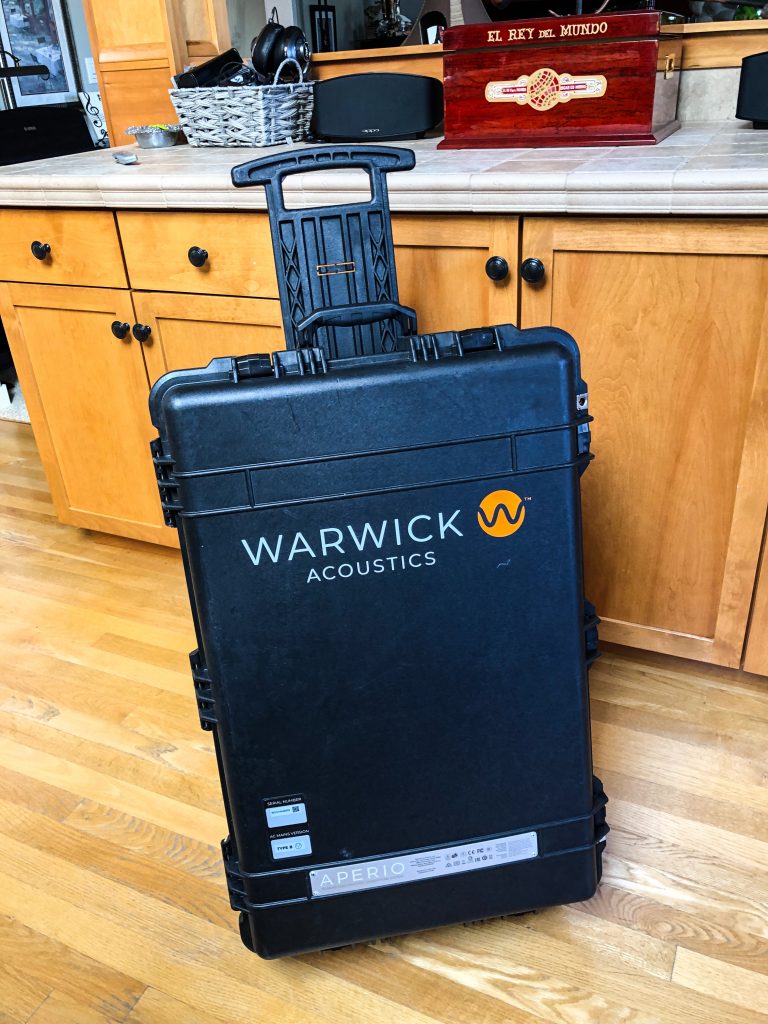
With real pleasure, I immediately unpacked the Aperio case…
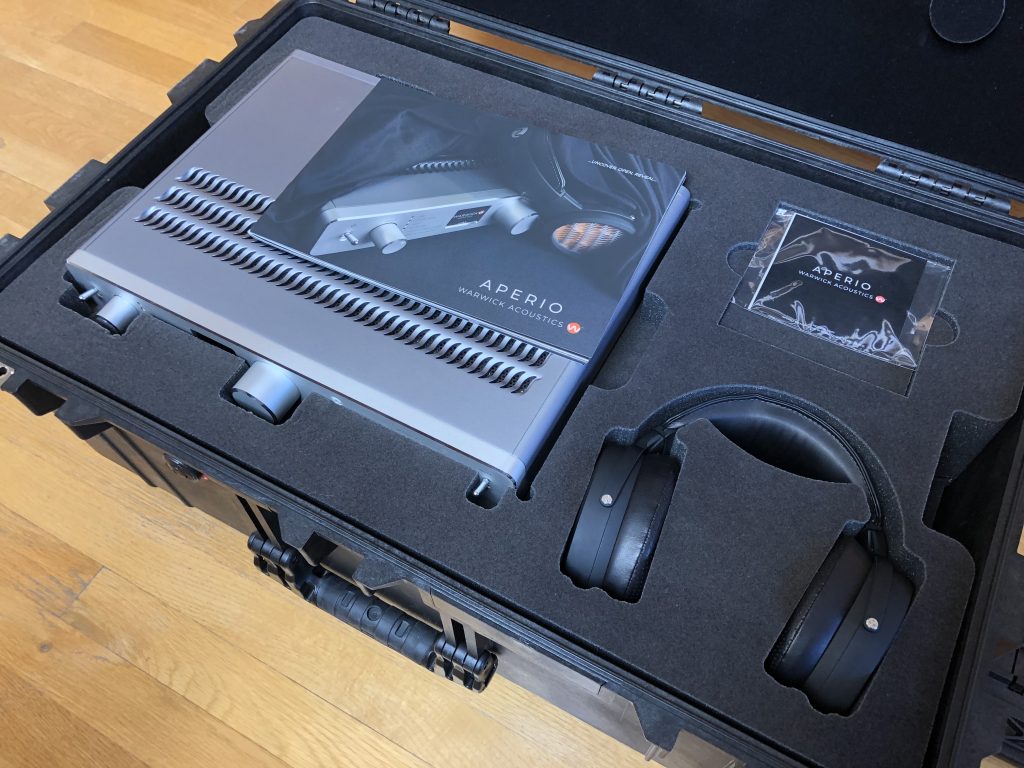
…which was in two layers of custom-cut foam. On top, there was the Aperio DAC/Headphone Amp/Preamp, with the new Balanced Drive High Precision Electrostatic Laminate (BD-HPEL) headphones and the quick docs.
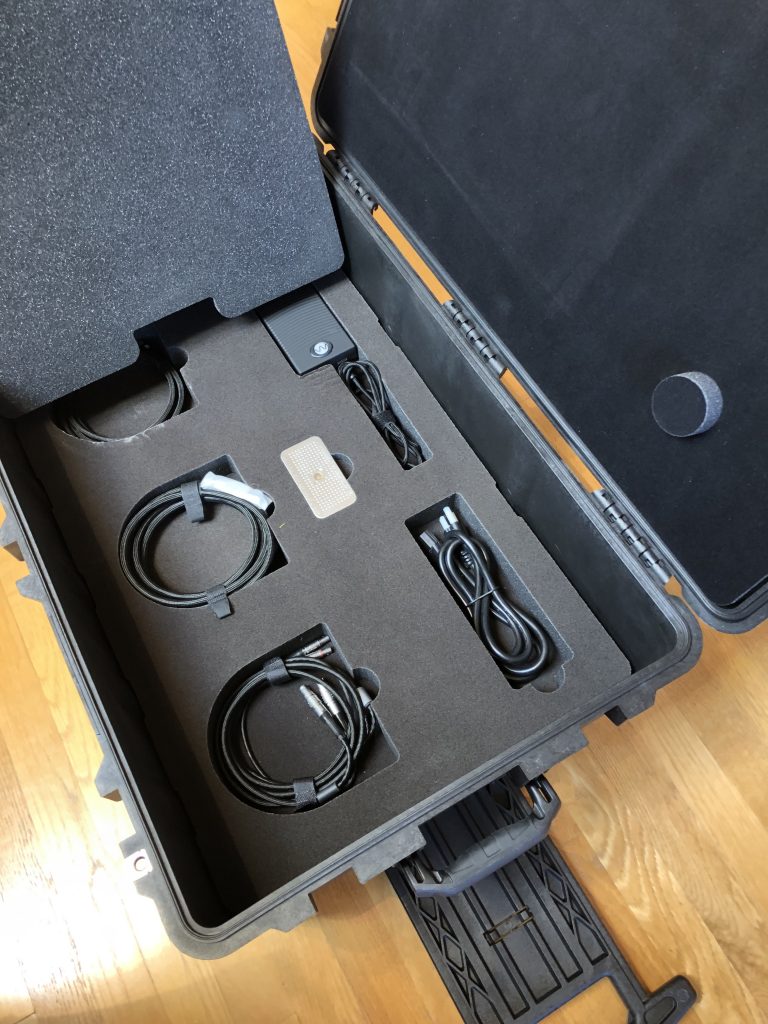
Next layer down was the Warwick Acoustics Power Supply for the Aperio, plus a set of various cables produced by them. The power cable is generic IEC, unfortunately. (I left that in the case, of course; right now, I'm using the Kubala-Sosna Realization Power Cable. Cheers!) All nicely organized, and easy to unpack or store again.
At last! The Aperio was at hand!
Or so I thought.
Unfortunately, the first iteration of the BD-HPEL headphones developed a problem shortly after their arrival. One morning I fired up the Aperio, put on the phones, and fired up some music.
Uh…no sound from the right driver. Dead-o. Nada.
An email to Warwick Acoustics followed immediately. They confirmed that they had located a manufacturing problem in the BD-HPEL 'phones. Time to return the Aperio system, mate!
So, I did.
Then I waited for the correction of the design to be made. This took longer than I thought it would, but the good folks at Warwick Acoustics assured me that they were working to get everything exactly right. Which is as it should be with a reference headphone system like this.
It took Warwick Acoustics a while to get this headphone issue straightened out. In fact, it was almost exactly a year later…mid-August of 2020…that the replacement Aperio system arrived here. Same glorious shipping case; same organization of parts and pieces. I got it set up quickly with our Dell Precision T7920 Workstation, a very powerful computer indeed, and proceeded with initial shakedown.
This time, I am delighted to say, there are no problems. Full speed ahead with the Aperio!
Before going further, here are the technical specifications from Warwick Acoustics' Web site:
Specifications
Headphones
- Configuration: Open-back; circumaural type
- Transducer; Balanced-Drive High Precision Electrostatic Laminate (BD-HPEL)
- Effective Diaphragm Area: 3570 mm2
- Frequency Response: 10 Hz – 60 kHz
- Output Level (SPL): Compliant with EN 60065/A12:2011 (EN50332) when driven by APERIO electronics (for all inputs); digital input: ∽ 104 dB; analog input: ≥ 106 dB (continuous, est.)
- Ear and Headband Cushions: "Cabretta" top-grain, sheepskin leather; perforated surface on ear cushions
- Input: Polarized, 4-pin, self-latching connectors for left and right channels
- Drive Cable: Dual mono, shielded, ultra-low capacitance; silver-plated OFHC ultra-fine stranded copper, with silicone insulation and Kevlar reinforcement; 2-meter length
- Weight: 405 grams (14.3 oz.), without cable
Electronics
- Balanced Analog Inputs: Dual (female) XLR jacks; switchable (high / low) input range; 18 dBu / 10 dBu
- Unbalanced Analog Inputs: Dual RCA jacks; switchable (high / low) input range; 5.0 Vrms / 2.1 Vrms
- USB Digital Input: Type B jack; USB 2.0; accepts digital audio formats up to 32-bit / 384 kHz PCM and DSD (DSD64/DSD128/DSD256) via DoP or Native
- Network (Ethernet LAN) Digital Input: RJ45 jack; DLNA-compatible; accepts digital audio formats up to 32-bit / 384 kHz PCM and DSD (DSD64/DSD128/DSD256) via DoP or Native
- AES3 (AES/EBU) Digital Input: XLR (female) jack; accepts digital audio formats up to 24-bit/192 kHz PCM
- S/PDIF Coaxial Digital Input: RCA jack; accepts digital audio formats up to 24-bit/192 kHz PCM
- Line Outputs: Balanced and unbalanced, high current outputs; +5 dB gain; switchable
- Digital Formats: PCM: 16-32 bit / up to 384 kHz; DSD: up to 256 fs DoP and Native
- Digital Signal Processing (DSP): 64-bit (double-precision) fixed-point processing at native sample rates
- Switchable Gain: Rear panel switch; high level / low level selection for balanced analog input (professional audio and consumer levels) and unbalance analog input
- Source Selection: Multi-position front panel selector with indicator LEDs for all sources
- Level Control: Front panel, 31-position; digital and analog domain volume control (HP & Line Out)
- Status Display: Front panel, 51 mm, full color, QVGA, TFT LCD (240 x 320 pixels)
- Display Functions: Digital readout and bar graph of volume control setting; display of digital audio data format; display of rear panel analog input (gain) settings; display of Ethernet and USB data link transmission lock; display of detected fault modes and output clipping
- Auto Fault Detection: Automatic detection, display and protection for: output amplifier clipping, unplugged connections and malfunctioning wiring, over-temperature conditions and internal electrical faults
- DACs: 2 x dual mono, 32-bit / 384 kHz DACs with balanced outputs, for PCM & DSD inputs
- Amplifier/Energizer: Balanced, discrete MOSFET, high-bias, single-ended Class A output; dual mono topology, including power supply; 1800 VDC bias (charge) voltage
- Distortion + Noise: < 0.001%
- Bandwidth: > 65 kHz
- Enclosure: CNC-machined 6063 aluminium; earth-grounded
- Power Supply: External: world voltage compatible (90-264 Volt AC, 50-60 Hz); 24 Volt DC, 200 VA (8.333 A), fixed frequency, class B-compliant SMPS. Internal: isolated, dual mono; switching and ultra-low-noise linear regulation
- AC Mains: Types B, G, F, I; IEC-60320 C14, earth- grounded power cable; 1.5 meter length
- Dimensions: H x W x D: 68 mm (2.68 in.) x 413 mm (16.26 in.) x 351 mm (13.82 in.)
- Weight: 7.4 kg (16.28 lbs.), without Power Supply
Setup and associated system
Now, on for it!
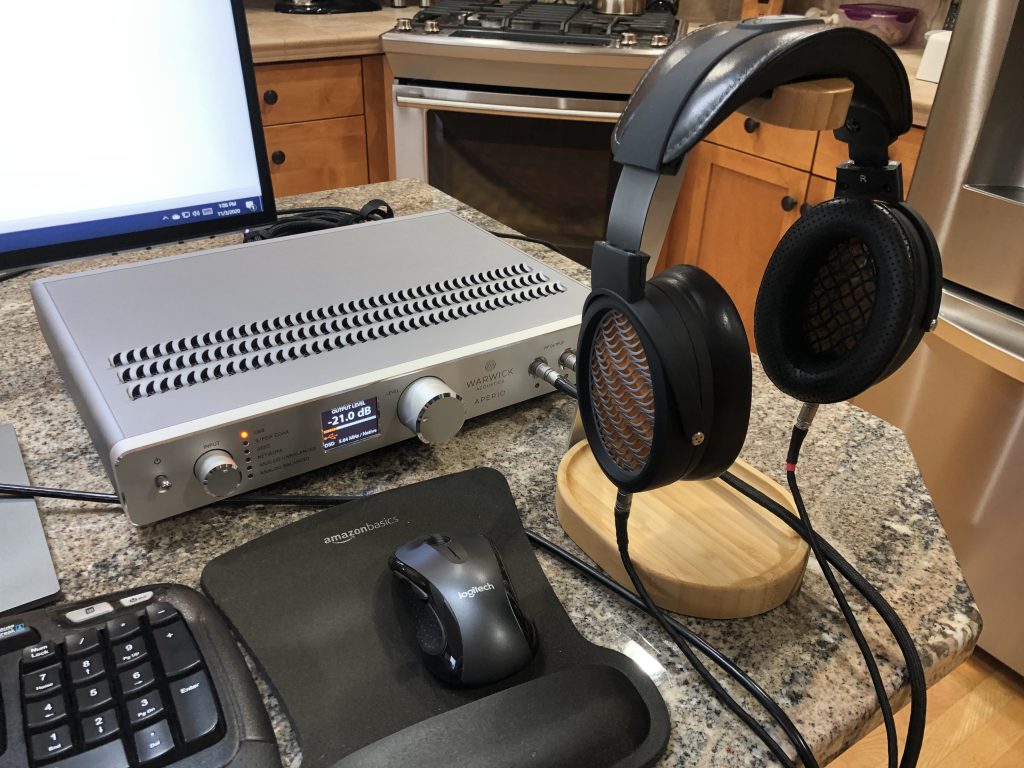
As mentioned, I am using my Dell Precision T7920 Workstation with Windows 10 Professional as the hub to handle playback for the Aperio system. This workstation features Dual Xeon Silver 4208 8-core processors/11 MB cache at 2.1 gHz, 64 GB of DDR4 @ 2933mHz ECC RAM, NVIDIA Quadro RTX 4000 with 8 GB of video RAM, for the record. In our current setting, I am going exclusively with the Warwick Acoustics USB cable, with the Dell T7920 acting as the music server. The local playback software is the always excellent JRiver Media Center 27, taking feeds from our Wolf Audio Systems QNAP 1273U NAS RAID 5 storage center (currently 84TB of RAID 5 storage) and from a local Seagate USB 3.0 hard drive.

To connect the custom power supply to AC, I did my usual casting aside of the generic IEC cable, and employed one of my reference cables, the exceptional Kubala-Sosna Realization AC Power Cable. The quality of the Realization series eclipses even the earlier glory of the K-S Elation! line of cables. With the Realization, I could be sure that I would be given exceptional detail and a lower noise floor, plus enhanced harmonic structure. (As you'll see below, that's what happened....)
For streaming, I use the Dell T7920 to access Qobuz, YouTube Premium, Amazon Music, Apple Music, and TIDAL. I can stream directly via Chrome from my accounts on those Web sites. In that last case, however, I'm not able to access TIDAL MQA mode, since the Aperio doesn't support MQA. Some might find that to be a major stumbling block…I didn't miss it, since I could shift to Qobuz for high-resolution PCM in .FLAC format, or go to other PCM source files.

(Right now, for example, I'm listening to the master recording of Sasha Matson's intriguing jazz opera wrapped around baseball, Cooperstown, in 88.2kHz/24-bit .WAV format, produced and recorded by John Atkinson. Via the Aperio, it sounds very good indeed!)
The Aperio itself
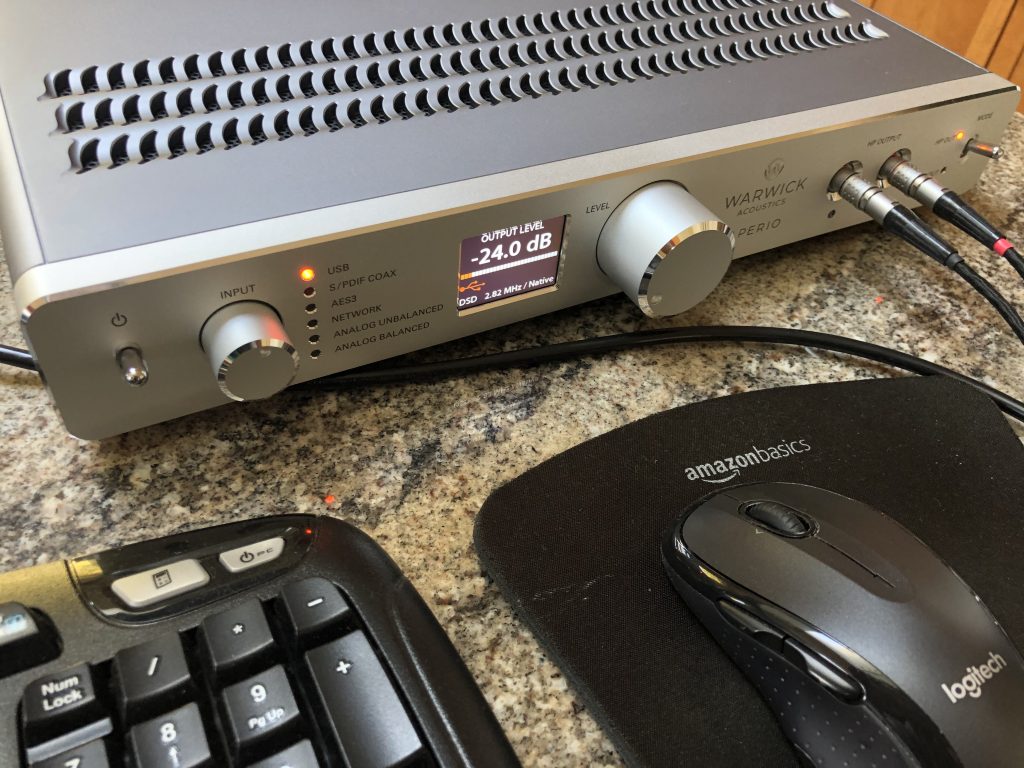
As noted in the specifications section, the Aperio is an exceptionally ambitious and well-executed design. Being fully dedicated on the headphones side of the ledger, with custom locking outputs to the BD-HPEL headphones, this is no generic connection. You won't be able to use the Aperio headphone amp with other electrostatic headphones. The power output of the electronics is quite nicely matched to the BD-HPELs. Most of the time, and depending on the volume level of the recording that I was listening to, I was at -24.0 dB. Some very dynamic recordings might require -30 dB; less-dynamic recordings, including rock recordings from the '60s or '70s (before the later "volume wars"), might go to -21.0 dB. Your mileage may vary, of course, since different people have different preferences, or different types of hearing damage/loss.
The front section of the Aperio has, from left to right: a hefty power switch; an input selector rotary knob (switching from USB to S/PDIF coax, AES3, Network [Ethernet], Analog Unbalanced, and Analog Balanced); a 320x240 pixel TFT color display for status; a large detented volume knob; a pair of dedicated, locking headphone output sockets for the BD-HPEL headphone cables; and a mode switch with headphone out and line out indicator lights.
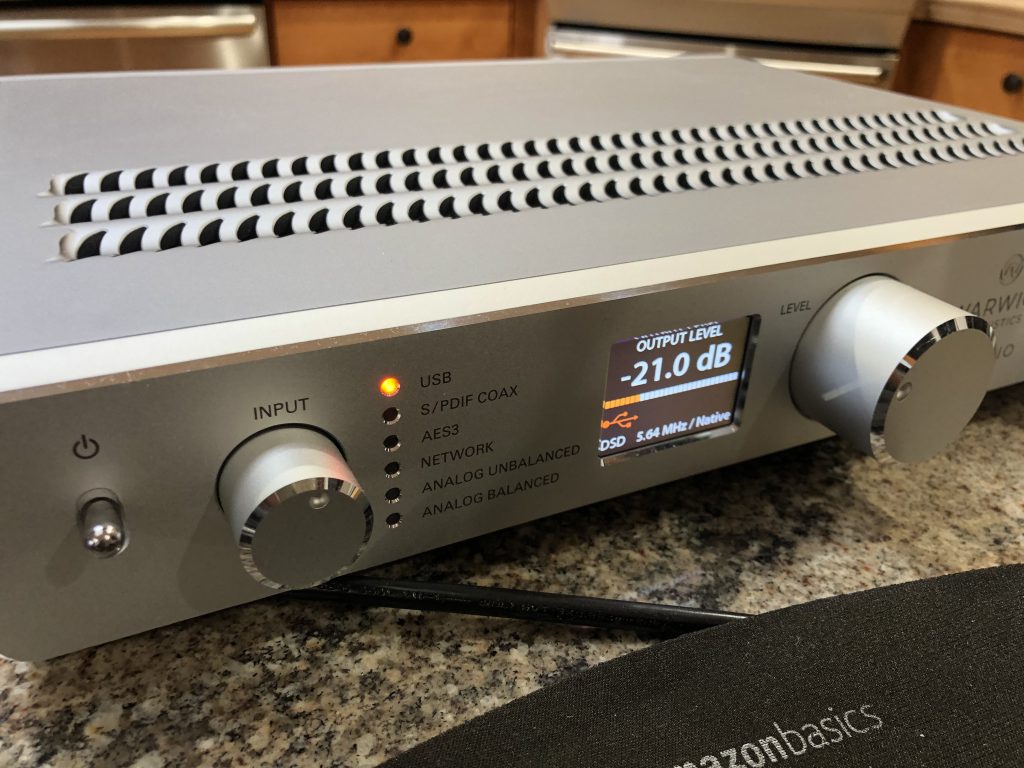
The front display is a useful piece of work. According to Warwick Acoustics, its functions include the "Digital readout and bar graph of volume control setting; display of digital audio data format; display of rear panel analog input (gain) settings; display of Ethernet and USB data link transmission lock; display of detected fault modes and output clipping." A very intelligent, self-monitoring system, with a very clear screen, headphone lovers are going to really appreciate the fact that the Aperio will let you know both the current volume, resolution/file type, your current input, and if there are any problems that it has detected. No guesswork or arcane indicator lights…this is clear and definite information.
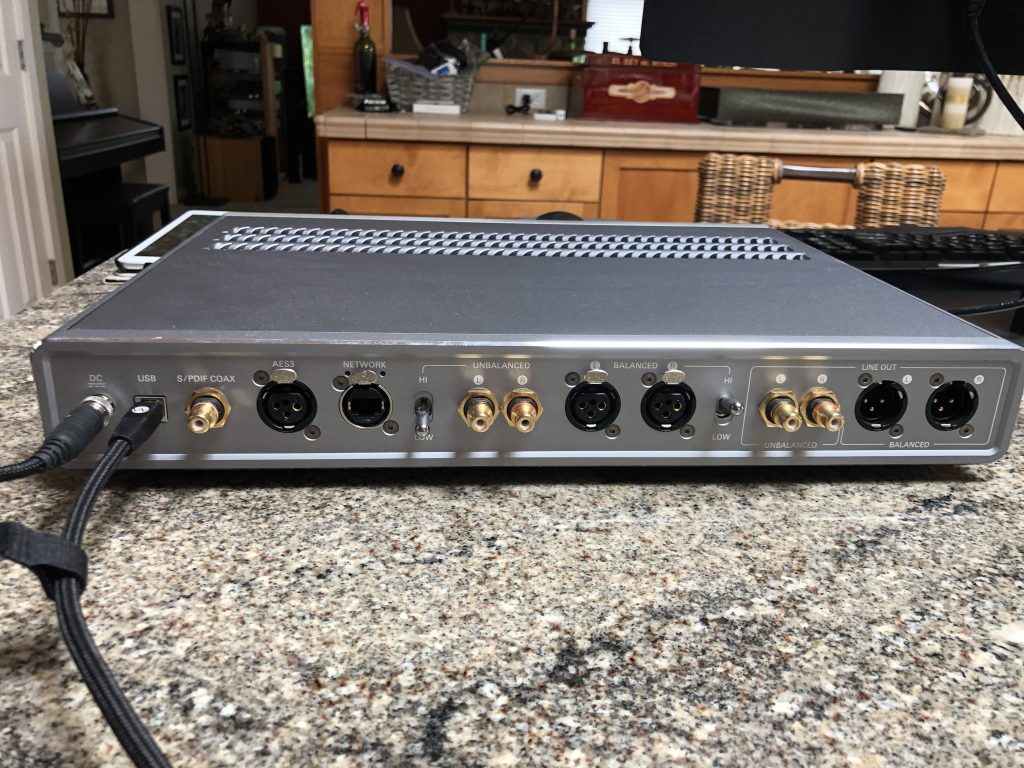
The rear of the Aperio features, from left to right: DC power input with screw-on clamp; USB 2.0 input; S/PDIF coax input; AES3 input; Network (Ethernet) input; switchable high-low gain for analog RCA analog inputs; switchable high-low gain for XLR analog inputs; RCA analog outputs; and XLR analog outputs.
The specification sheet has some notable points. To hit some highlights for me: A frequency response of 10Hz – 60kHz. An SPL output of around 104dB (ouch!). Cabretta sheepskin headphone pads on injected magnesium ear cups. A seriously upgraded BD-HPEL membrane. Support for DSD is now up to DSD256 (Quad DSD) in both Native and DoP modes. PCM is supported up to 384kHz/32-bit, with 64-bit double-precision processing. The DAC chipset is a pair of dual mono ESS ES 9028PRO chips, well known and well regarded in high-end audio.
The amplifier section itself is a real piece of work. Warwick Acoustics lists it as being composed of "Balanced, discrete MOSFET, high-bias, single-ended Class A output; dual mono topology, including power supply…" It's definitely a powerful headphone amp…no doubt about its Class A operation, as attested to by the fact that the Aperio gets noticeably warm during extended operation. Not hot…but warm. You'll notice that it has cooling vents done in the distinctive Aperio swirl, both above and below on the chassis, allowing natural convection to cool the unit. I've run it for several days continuously, without any overheating. This is real-world goodness, obviously made for the audio professional, and not just for the audiophile at home. Note that the external power supply itself has an IEC connector so that you can use the upgraded power cable of your choice. It's also rated for international use; Warwick Acoustics states that the Aperio power supply is "world voltage compatible (90-264 Volt AC, 50-60 Hz); 24 Volt DC, 200 VA (8.333 A), fixed frequency, class B-compliant SMPS." Internally, it is "isolated, dual mono; switching and ultra-low-noise linear regulation."
There's plenty of bingo! there.
The custom dedicated input cabling (USB 2.0 and Ethernet) for the Aperio are described in this way: "Warwick Acoustics supplies two high performance input cables with the APERIO: a USB 2.0 Type A to B cable, and an Ethernet cable. These cables are custom designs, developed by Warwick Acoustics to match the performance and quality level of the rest of the APERIO system. Both cables utilise superior SF/FTP construction, with double overall shielding (aluminium-mylar foil and copper-plated Aramid fibre braiding) as well as internal shielding of each of the double-helix twisted pair conductors. All internal data wiring is formed from 66 strands of micro-fine OFHC copper per conductor, each plated in pure Silver. The wiring insulation is high-grade Polyethylene (PE), with a very low dielectric constant (< 2.0). The outer jackets are formed from low durometer Thermoplastic Elastomer (TPE) covered with a multifilament woven Polypropylene braid for durability and a soft texture.
The USB cable connectors are high-quality, gold-plated Type A and B plugs. The USB cable is designed to be impervious to noise, interference and emissions while maintaining an optimal 90 Ω characteristic impedance over the full operating bandwidth; it is fully compliant with USB 2.0 standards. The Ethernet cable connectors are the finest quality, ruggedised plugs available: professional, full-metal shielded XLR (RJ45) type from Neutrik and universal, full-metal shielded RJ45 type from Telegärtner. The Ethernet cable also is designed to be impervious to noise, interference and emissions and maintains an optimal 100 Ω characteristic impedance over the full operating bandwidth. While the connectors are certified as CAT6A type, the cable is compliant with CAT7 standards."
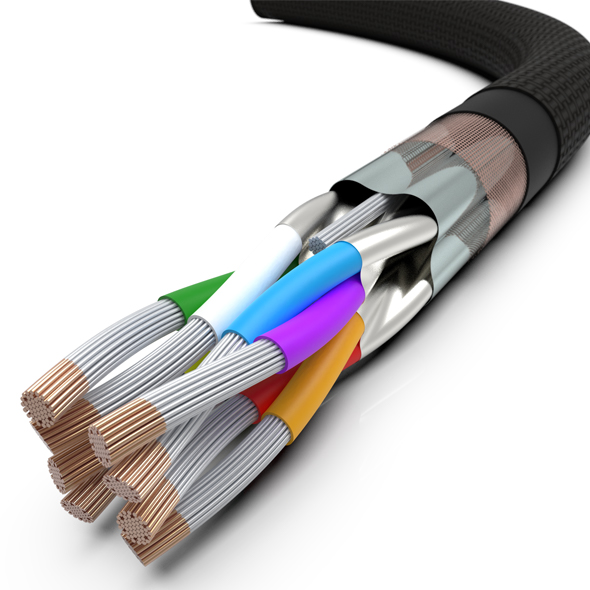
Impressive stuff…and having used the Warwick Acoustics USB 2.0 cables for months, I can say that these are first-rate in finish and the delivery of the music. Sounds terrific, and both the USB and Ethernet cables are built like tanks.
To round out, the physical dimensions of the Aperio are 2.68 inches high x 16.26 inches wide x 13.82 inches deep (68 mm H x 413 mm W x 351 mm D). It tips the balance beam at a very solid 16.28 pounds (without the external power supply)…pretty hefty for a headphone amp/DAC/preamp. The Aperio electronics themselves are built in the USA…the East Bay area of California, to be precise. The BD-HPEL headphone transducers are built in Warwick Acoustics' facility in the UK, where extremes of care, testing, and matching transducers are practiced. These folks are audiomaniacs!
Which is a compliment.
The Sound

"Surfer" by Dan Zimmerman, 1963
The sound.
It always comes down to this, for better or worse.
Once the final version of the Aperio system arrived, I downloaded the latest version (4.59.0) of the ASIO drivers for our Windows 10 Pro workstation. The updated ASIO was solid enough. I gave it a run-out on the original version of the Aperio firmware. There was a problem that I noticed pretty quickly, however: the volume detents went too quickly from -80dB to -60dB to -30dB and on downwards. There simply wasn't enough granularity of volume; for me, things were either too quiet, or, too quickly, too loud.
To their credit, the Warwick Acoustics team had already noticed this problem. When I informed them of this, they told me that they were already working on a firmware update to correct this. Not too long thereafter, good to their word, they emailed me the necessary software to update the Aperio to the current (as of this writing) 1.1.1 version of the firmware. Once installed, it provided a new set of volume settings for the volume control detents…much better! Right on when it came to the granularity and comfort of the volume range.
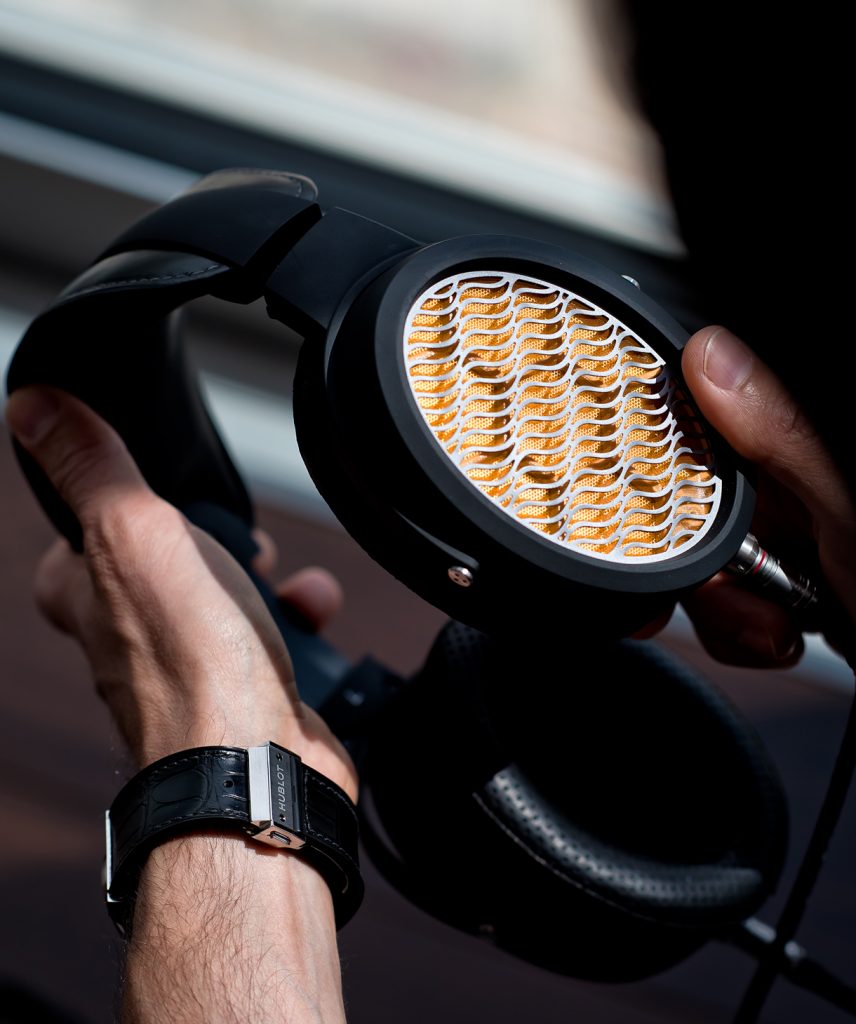
First, a note on break-in. My initial listen, right out of the box, indicated that the Aperio showed remarkable possibilities, but that it would need some time to bloom. My experience was that both the headphone transducer as well as the DAC/headphone amp would improve over time. How much time? That varies. The only way to know is by running things out and knowing by extended experience when audio components "bloom." (When you've hit critical mass on listening, you'll know it when a component blooms.) And so, I would leave the Aperio system running all day long, with Media Center 26 and 27 in album-repeat mode. Media Center 27 is our current revision, and is the software that I played all LAN-/NAS-based music for this review, especially DSD out to DSD256. I'd vary the album from time to time throughout the day, shifting genre/artist on a regular basis. Lots of full-range recordings, varied with recordings that were less so. Diversity.
Additionally, PCM got a workout via computer-based playback of Qobuz and TIDAL (without MQA, since the Aperio doesn't support it.)
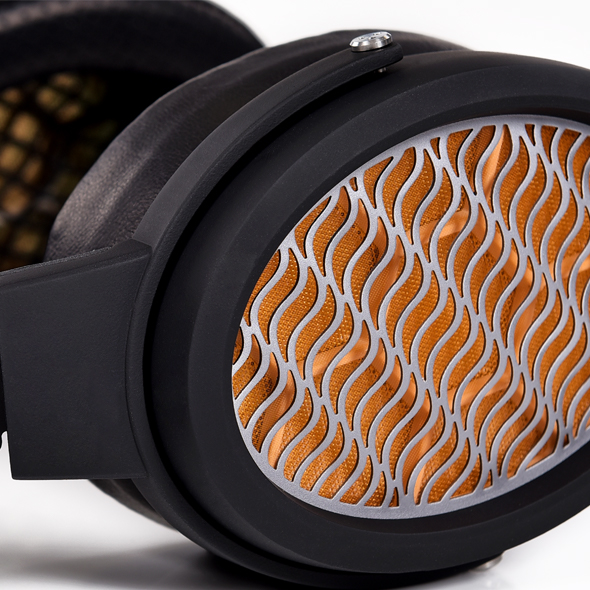
I found that the Aperio headphones seemed to drop into place between 50 and 100 hours. The electronics took longer, as I expected with a DAC. DACs usually take more time. In this case, I felt that the full drop on the DAC side happened at 300-400 hours of listening time. This is all within the envelope of usual and customary time here at PF Central.
Once broken in, I was able to sort through the audio virtues of the Aperio. These have turned out to be prodigious.
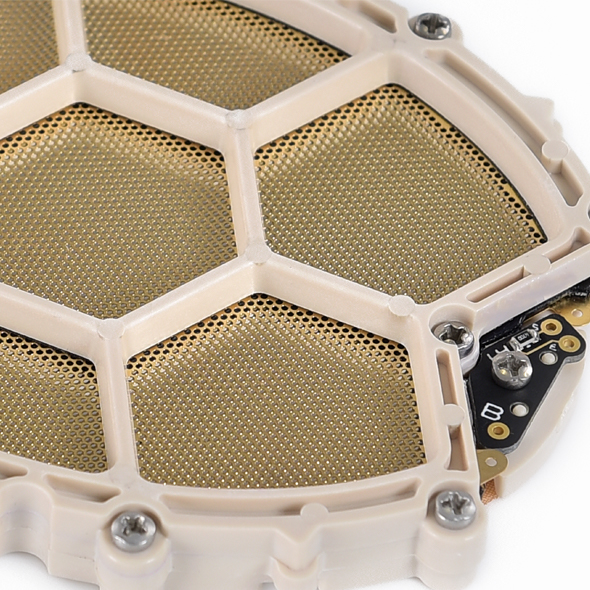
First of all, the Aperio features stunning transparency. The BD-HPEL transducer clearly out-points my experience with the earlier Model One, and not by a little. The R&D that went into the Aperio's headphone design has resulted in an extraordinarily "here-but-not-here" quality, almost as if there is no transducer at all. And since, in my book, transparency is the gateway to all the other audio virtues, this opens the floodgate for:
Detail: The Aperio really allows all of the nuances of a recording to come through. You can hear into recordings deeply, and appreciate elements that you've never noticed before…even if you've known a recording for many years (or even decades). I have had moments with the Aperio when I've been brought up short, hearing things that I've never noticed before in a given track. Assuming that you know what you're listening to very well, you'll likely find new elements to surprise you. That will be especially true with remastered albums.

Right now, for example, I am listening to the TIDAL Master version (without MQA) of Keith Jarrett's album on ECM, Creation. His legendary humming-along-with-himself is quite evident. (Keith is definitely a soul brother of Glenn Gould...)
High frequencies: With the upper end reaching upwards of 60kHz, and given the open back design with its I-can-see-through-it transducer, it's no particular surprise that the upper reach of the Aperio is so very satisfying. There is a superior lightness, a spaciousness that can be quite challenging to attain with headphones. No problem for the Aperio, though; music arrives like a Will-o'-the-wisp.
Midrange: Well, here's home base, of course. I'm pleased to say that the midrange via the Aperio is wonderfully balanced. The mids don't dominate the frequency ranges at all, but are extremely well integrated with both aloft and aloo. Listening to all genres of music revealed a mastery of audio shalom among the various tonal ranges, with the midrange simply being there, itself, without any forwardness or honky-tonky in-your-face qualities. For me, the mids were exactly where they needed to be, regardless of the recording that I was listening to over the months.
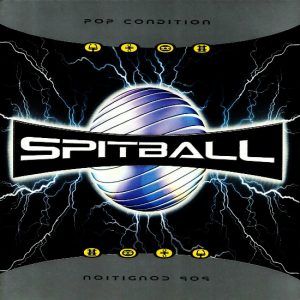
Bass: Present, but not boomy or uncontrolled. Specified as reaching down to 10Hz, the Aperio headphones/electronics are up to the challenge of deep bass. Electrostatic designs in both the worlds of headphone and loudspeaker design have a stereotypical reputation as lacking in the lower end. Not the Aperio! One of my acid tests for bass is my SACD (and also my DSD64 file), Pop Condition by Spitball. It was recorded directly to DSD64, and mixed there as well; no intervening analog or PCM layers. The bass on many tracks of this album is quite scary; I have to be careful with loudspeaker playback of Pop Condition. But the Aperio handles the deep bass with controlled extension.
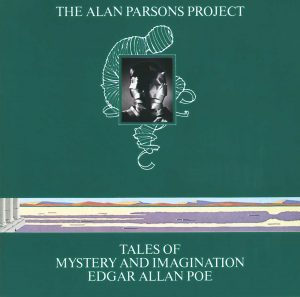
Dynamics: No problems here! My ears gave out before I ran out of volume on powerful passages like "The Fall of the House of Usher" sequence on Alan Parson Project's Tales of Mystery and Imagination. (These are headphones. I assume that you all are exercising real care while listening, since overdriving your ears with headphones over time can lead to significant damage to your hearing. Don't be stupid; keep your listening reasonable.) And yet the quietest passages of, say, Chopin's Nocturnes were rendered with pleasing presence and wonderful nuance. No ear strain at all. The dynamic range of the Aperio was not overrun at any point of wise gain levels.
Very gratifying.

Harmonics: The tonal structure of the Aperio system was likewise well balanced and satisfying. Once the system had bloomed, there were no discontinuities of harmonic integration. It was lovely to hear one of my favorite Mahler Symphonies, No. 2 (The Resurrection) in DSD64 via the Aperio. This is an exceptional performance and recording, which was really a wonder to experience with Warwick Acoustics Aperio system. Lovers of classical music will have great cause for rejoicing! (If you would like to purchase the complete Mahler symphonic cycle in DSD64...Single DSD...just go over to Cookie Marenco's Blue Coast Records site and browse through THIS PAGE.)
And while listening to Brian and Roger Eno's Mixing Colors (see below), I was able to discern overtones, harmonic resonances, and even vibrational effects that I had not noticed before in many listening sessions. Audiophiles will love this…but, even more, professional audio engineers and recordists are going to really appreciate the fantastic performance of the Aperio.
Presence: In spades. Music in all formats…but especially noticeably in DSD128 or DSD256…simply is. It floats in space without effort. Which is related to…
…Soundstaging and imaging: Normally, there are all sorts of limitations when one considers these qualities in a headphone. This is because the headphone experience doesn't allow for the usual development of sound in space the way that loudspeakers do.

Nonetheless, I was surprised by the sense of spaciousness that the Aperio manifested. There was a real feel of some room betwixt the transducers and my ears, not producing the quasi-claustrophobic clamping that some headphones induce. Recordings with excellent soundstaging and imaging, like my decades-long reference, Stokowski Rhapsodies on DSD64, did sound truly expansive…more than the usual reaction I've had to other headphone systems. And even lower resolution recordings like Brian Eno's recently released Brian Eno – Film Music 1976-2020…

…at 44.1kHz/16-bit on Qobuz was surprisingly atmospheric. (And boy, do I love Eno.)

Ditto his 2020 collaboration with his brother Roger on the superb and haunting Mixing Colors. You can drown in a sense of ambience here, despite streaming at a lower resolution from Qobuz than I would like. (DSD please!) The Aperio made listening to this album more pleasant and atmospheric than I would have believed.
This is very encouraging, since the closed-in feeling of all too many headphone systems can be a real turnoff, leading to truncated listening sessions and "headphone headaches." Who needs that? Additionally, the perforated lambskin headphone pads, which are replaceable, made multi-hour listening quite comfortable for me.

And my beloved Reiner Respighi Pines of Rome • Fountains of Rome in DSD64? It floats and shimmers, growling deeply, reaches skywards, and does so effortlessly. The quiet and delicate passages of "Pines Near a Catacomb" or "The Pines of the Janiculum," contrast wonderfully with the monumental "The Pines of the Appian Way," a movement that I have always felt gave Holst's "Mars" more than a run for its money. DSD has never sounded better on headphones, as I have listened for hour after hour during these COVID-19 months (after months after months). This is another acid test for my audio evaluations, and the Aperio system passed with flying colors.
Texture: The ability of the Aperio to lay clear the palpable touch of recordings gratified me again and again. Years ago, I jotted a note to myself about a sudden realization given to me:
"What's missing is touch."
Just as surely as we need to embrace, to touch, to feel skin on skin, we need our fine audio systems to deliver music in a way that allow us to be transformed by the very feel of the "skin" of our recordings. If we can't place the hands of our soul on the textures of the music as they flow past, over, and through us, then we are missing the tactile dimensions of recordings and these possibilities in the audio arts.

Untitled, by Dan Zimmerman
Flow and organic unity: For a headphone system, these qualities shone with the Aperio. Everything seemed musically balanced, whole, and with a compelling ease and naturalness to the music. This was done without any sense of loss to detail or the ability to look within a recording, which is quite a signal accomplishment. The BD-HPEL headphones, driven by the synergistics of the Aperio electronics, so very tightly matched, bring feel and flow…the textures…of our music front and center. And they do so without inflicting headphone claustrophobia over time. That's golden!
Their rendering of detail…the little things of a given performance and recording…is second to none. Regardless of the hundreds of songs and albums that I listened to with the Aperio, the sense of listening into those fine details was never lost.
Remarkable, truly remarkable.
Digression on a further gain: the Aperio with the Synergistic Research MiG (Mechanical Interface Grounding) SX devices
One sonic advance that I was able to obtain over the baseline virtues of the Aperio System occurred when I shifted it onto a set of three Synergistic Research MiG SX Mechanical Interface Grounding devices. I have been using SR's MiG devices for years…the MiG 2.0s. These have brought sonic improvement to every audio component that I have used them with.
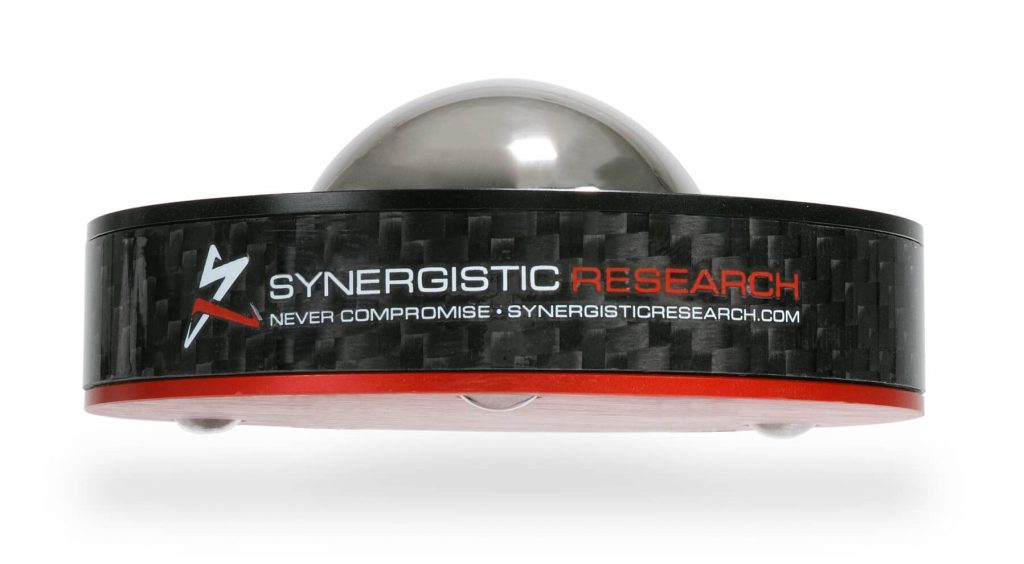
The next-generation MiG SX are more complex than the 2.0 version.
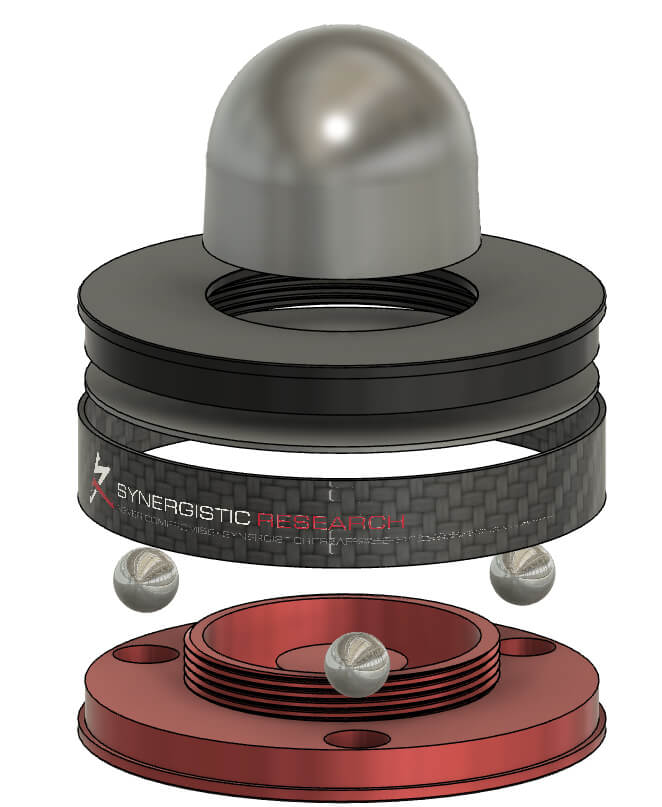
Taking Ted Denney's earlier concepts to a higher level, the MiG SX devices did bring a greater clarity to the playback of the Aperio when I used them in this application. I had been listening to the Aperio for 300-400 hours when, on sudden impulse, I tried the set of three MiG SX with it.
I immediately noticed a subtle lowering of an already low noise floor. There was a slight, but definite gain in transparency, with improved sonic details. As a result, I am hearing what seems to be even better high frequencies…more air up there…and the Aperio is no slouch at all in any of these regards.
I've been listening to the Aperio with the MiG SX for many days now, and don't think that I would like to separate them. Nor should you. If you decide to purchase the Warwick Acoustics Aperio, you should also acquire a set of three SR MiG SX, as well, as a highly…er…synergistic match.
So, the MiG SX will remain with the Aperio system henceforth, with my blessing!
There's more! The Aperio in numbered, limited edition gold finish…
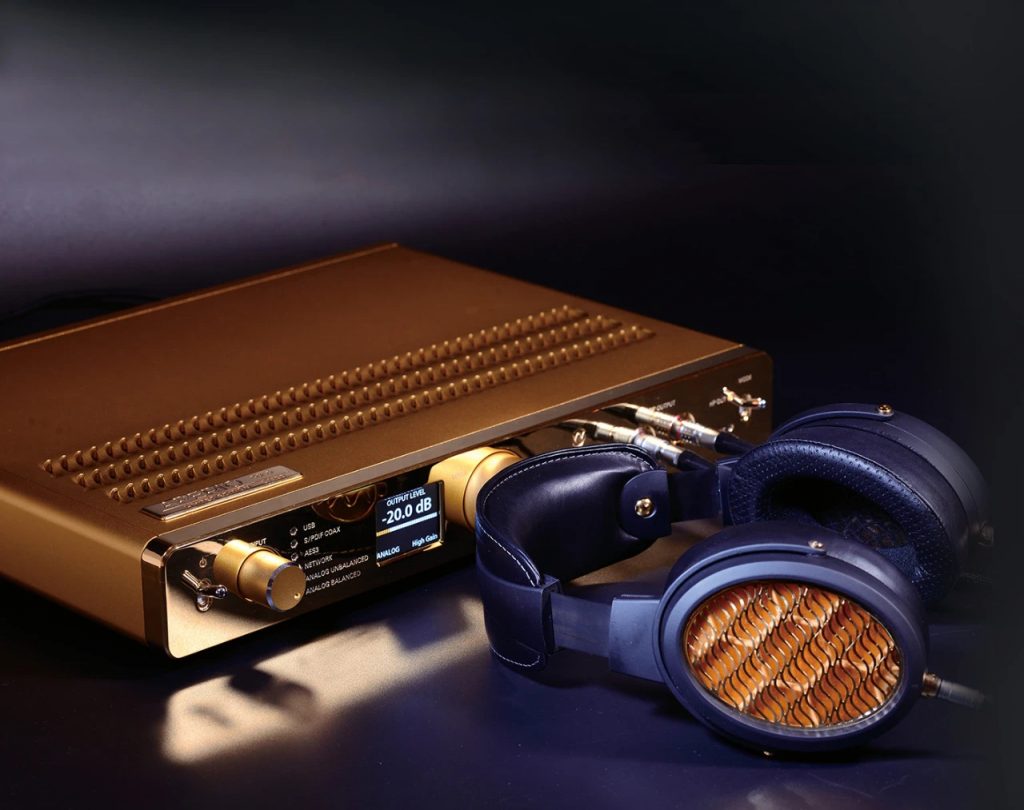
Not only that, but for those who lust for gold, Warwick Acoustics also has a stunning numbered-and-limited-edition version of the Aperio. The Aperio Gold has all of the same functions and features as the silver finish version, but it struts those in killer style.
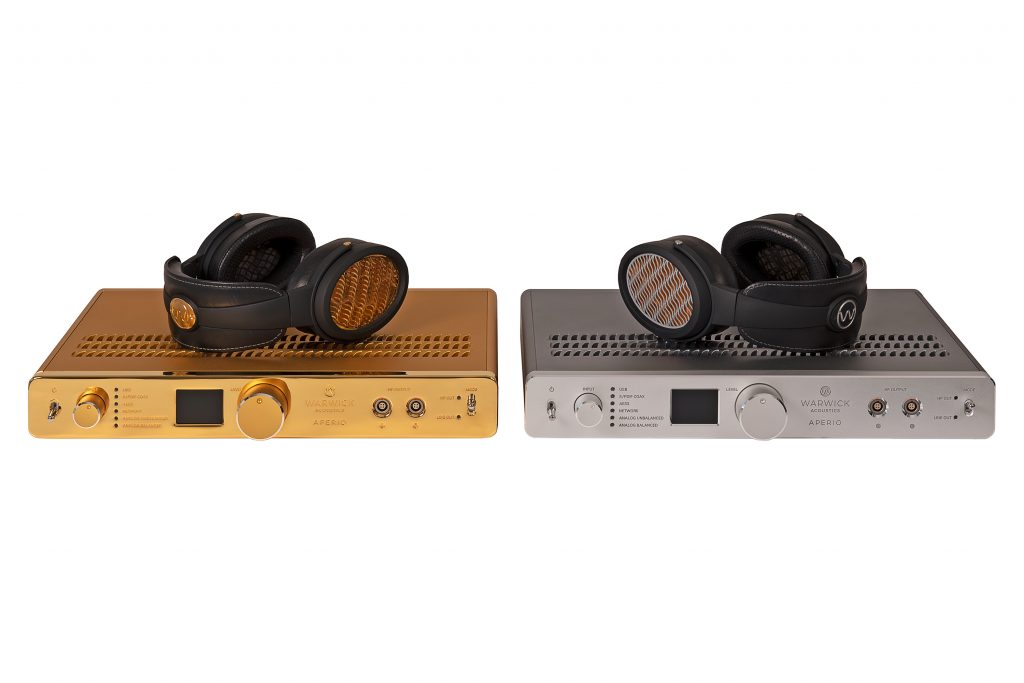
Killer. Style.
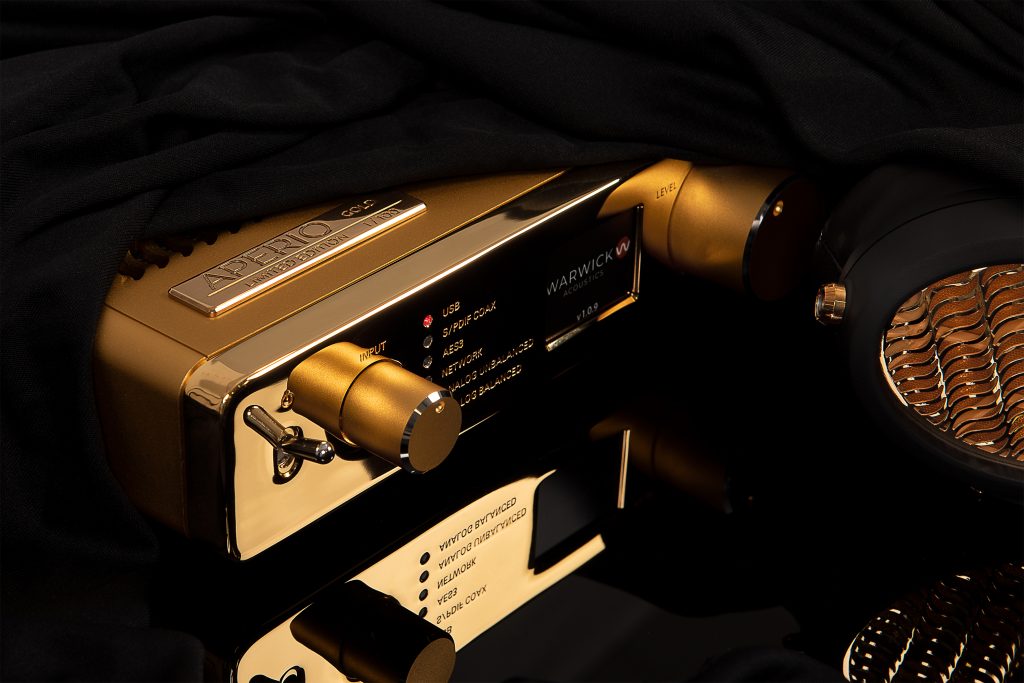
This is for the well-heeled audiophile at USD$35,000, obviously, but if you have this level of bucks, the Aperio Gold will certainly let you flaunt it.

"Conspicuous consumption," Thorstein Veblen called it.
I can dig it.
A loose note or two
A few additional observations for you:
- Given the way that Windows 10 handles ASIO driver loading, both the experts at Warwick Acoustics and my own experience indicate that you should wait for your computer to boot completely before you switch on the Aperio electronics. This allows Windows to be ready to initialize the USB interface for the Aperio. You should then get the standard Windows tone when the Aperio is recognized. If you don't do this, then the Aperio may not properly activate on that interface.
- I find that the headphone covers and pads are large enough for my ears, which, while not being gigantic, are large enough to have caused me discomfort with some headphones. "Around the ears" should not feel like "on the ears." I don't think that most people will have any trouble with the superior fit and feel of the Aperio headphones.
- My evaluation of the Aperio are based upon use of JRiver Media Center 27, Qobuz, and TIDAL, all via the Warwick Acoustics USB. My current setup did not allow me to try the Warwick Acoustics Ethernet cable, since I have been situated out of range of my managed Cisco switch for the Aperio. (My Dell Precision Workstation is running a long CAT7 cable to that managed switch.) Media Center 27 was in local operation on my workstation; Qobuz and TIDAL accessed from local apps on the workstation.
- A reminder: The Aperio system does not support MQA, and so your TIDAL Master account files will all be played at the baseline rate. (I am aware of the fact that there was at least one online review that said that the reviewer enjoyed the MQA playback of the Aperio. Uh…no.)
- Another reminder: The Aperio is not a Roon-ready system, but Warwick Acoustics assures me that it works just fine as a Roon End-Point, and that they use Roon with the Aperio for testing and demonstration purposes all the time.
- As with all electrostatic designs, the Aperio BD-HPEL headphones should be handled with care. Place them carefully on your head, and get a good, solid headphone stand for them.
- The ultra-comfortable lambskin ear pads are user-replaceable, and can be ordered from Warwick Acoustics. Check their Web site for details.
- The Aperio amp/DAC is a Class A device, which means that it generates heat. Make sure that you place it in a location where its airflow is not restricted.
Final thoughts…

"Thoughts" by Dan Zimmerman
Having heard both the Sonoma Model One and now the Warwick Acoustics Aperio Silver…
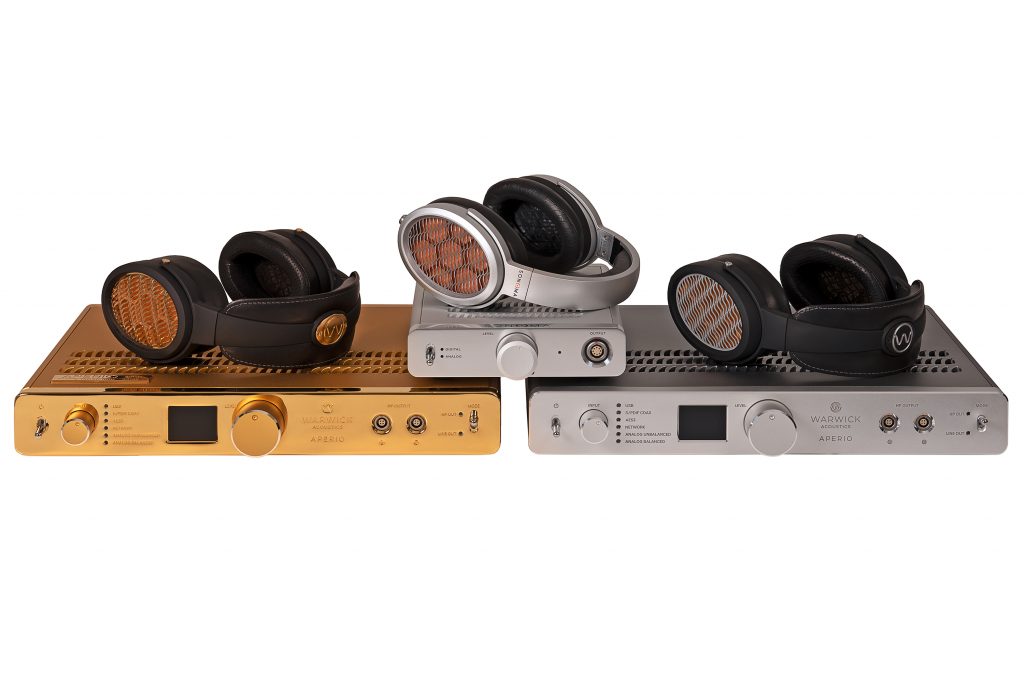
…I can say that Warwick Acoustics have finally fulfilled the extraordinary promise that I first heard in their line years ago. Patience has paid off, monumentally…and the results speak for themselves. (Or would, if they could speak. That's why I'm here.)
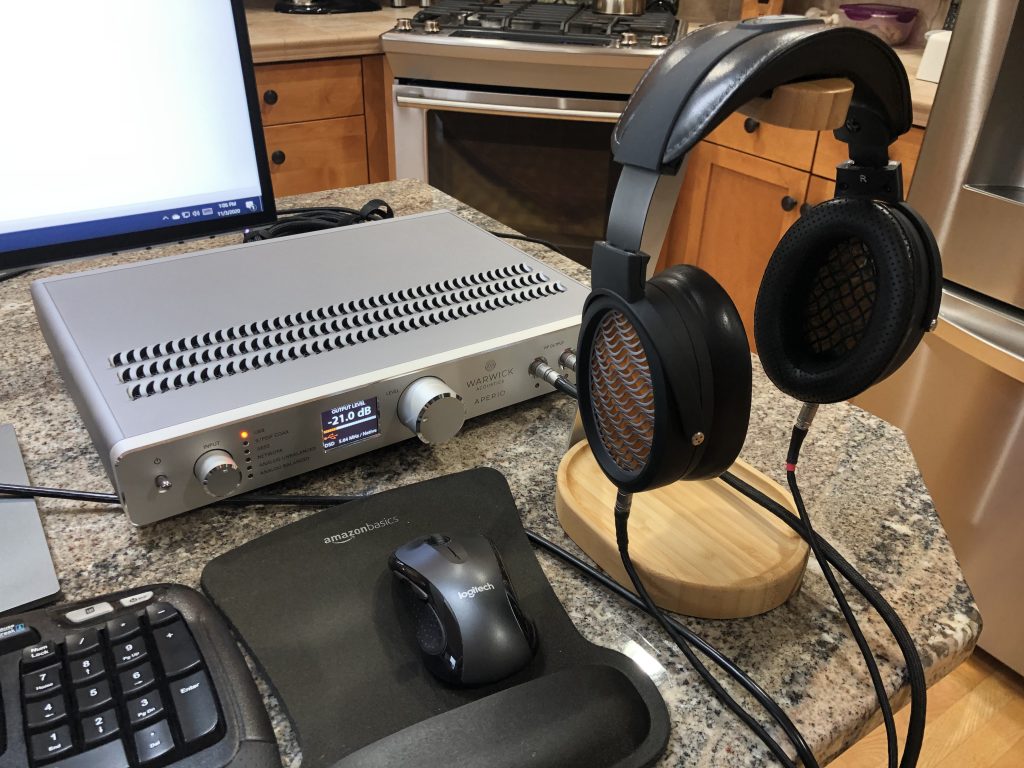
Combining lambskin comfort and light, open headphones, with the exceptional BD-HPEL transducers, the fully-dedicated Aperio system embodies the highest levels of transparency, detail, and clarity. The dynamics are more than your ears will take! The harmonic structure is exceptionally balanced, with no sense of roll-off at the high frequencies. It does this without leaving the lower frequencies behind. The sense of soundspace is remarkable. There is real presence with the Aperio, with actual decay being discernible. Nor is the listener left worn out with heavy, closed-in sound, as I can confirm after many sessions…over months…of multi-hour listening.
There is no doubt about it in my mind: The Aperio Headphone Amp/up-to-DSD256 DAC/Preamp sets a new global standard for all headphone systems to aspire to. This is world-class audio performance of the highest level of achievement.
Therefore, the Warwick Acoustics Aperio System receives a "Ye Olde Editor's 'very highest recommendation'"…with great delight!
Warwick Acoustics Aperio System
Retail: USD $24,000
Warwick Acoustics Aperio System in Gold
Retail Price: USD $35,000
Custom versions are available; contact Warwick Acoustics for more information.
Warwick Acoustics
https://warwickacoustics.com/headphones/collection/aperio/
Email: use the contact form at their site
https://warwickacoustics.com/headphones/find-a-store/
Synergistic Research
MiG SX
Retail: set of three: USD $995.00
Synergistic Research Inc.
11208 Young River Ave.
Fountain Valley, CA 92708
949.476.0000
Email: Use the company email form online at https://www.synergisticresearch.com/contact/
All product photographs courtesy of Warwick Acoustics and Synergistic Research. Show photographs and PF Central photographs and image processing by David W. Robinson. Portrait of Ye Olde Editor by John Robinson, with image processing by David W. Robinson. Various drawings and paintings by Dan Zimmerman. Photograph of Thorstein Veblen in the public domain.




